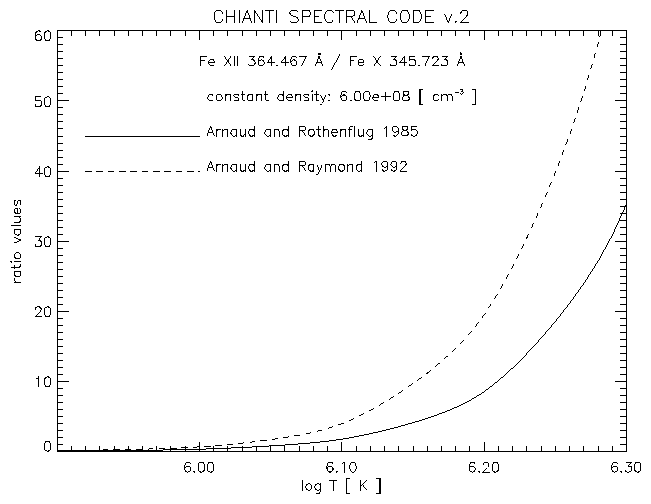The theoretical intensity ratios from individual ion species provide a measurement of electron density which is independent of any assumptions about the volume of the emitting region.
DENS_PLOTTER and TEMP_PLOTTER are high-level widgets for the analysis of density- and temperature-sensitive ratios of lines from the same ion. They allow inclusion of proton rates and photoexcitation. The calling sequence is simple:
IDL > dens_plotter,'o_5'
to study O V.
IDL > temp_plotter,'c_4'
to study C IV.
|
Figure 41 shows the density-sensitive Si IX ratio calculated at three temperatures (T=106 K is the temperature of maximum ionization fraction for Si IX), showing that these temperature variations do not appreciably affect the ratio.
The radiation that comes from the solar photosphere can excite transitions between levels in the ground configuration of ions in the corona, mainly affecting the level balance calculations for low densities (Ne £ 108 cm-3).
The effect is stronger close to the photosphere, and tends to die out with height because of the decrease of the photospheric radiation field with distance. This decrease can be accounted for by estimating a geometric dilution factor that is a function of height above the photosphere. Si IX should be affected more than other ions.
|
| Ion | Ratio (Å) | Detector | log Tmax | log Ne | |
| Si IX (*) | 349.9 (3) / 341.949 | N 1 (G 4) | 6.02 | 7.5 - 9.5 | |
| Si IX | 345.100 / 341.949 | N 1 (G 4) | 6.02 | 7.5 - 9.5 | |
| Si IX | 349.9 (3) / 345.100 | N 1 (G 4) | 6.02 | 7.5 - 9.5 | |
| Si X | 356.0 (2) / 347.402 | N 1 (G 4) | 6.12 | 8.0 - 10.0 | |
| Fe XII | 338.278 (!) / 364.467 | N 1 (G 4) | 6.16 | 7.0 - 12.0 | |
| Fe XIII | 321.4 / 320.80 | N 1 | 6.21 | 8 - 10 | |
| Fe XIII | 318.12 / 320.80 | N 1 | 6.21 | 8 - 10 | |
| Fe XIII | 359.6 (2) (!) / 348.18 | N 1 (G 4) | 6.21 | 8 - 10 | |
| Fe XIII (*) | 320.8 (bl) / 348.18 | N 1 | 6.21 | 8 - 10 | |
| Fe XIII (*) | 203.8 (2) / 202.044 | G 1 | 6.21 | 8.5 - 10.5 | |
| Fe XIV | 353.83 (!) / 334.17 | N 1 (G 4) | 6.25 | 9.0 - 11.0 |
Table 2 presents a list of useful density-sensitive line ratios available within the CDS channels. Only the principal usable ratios are listed, involving pairs of lines seen by the same spectrometer and detector.
The lines indicated with a (!) have problems in either their observation or in the atomic physics. This is based on experience gained in analysing different source regions (e.g. on-disc, off-limb, coronal holes, quiet sun, active regions) with the different detectors, and on the best possible line identification, with DEM analysis of the various regions.
Further examples and details are given in my thesis.
|
It is common in the literature to use only a few well-behaved line ratios, without considering all the observed lines. A different approach, preferable when more than two lines from an ion are observed, is to plot the values of
| (19) |
as a function of electron density, calculated at a fixed temperature. All the curves should cross at one point, if the plasma is isodensity. The Fji curves should be calculated at the effective temperature, i.e. at the temperature where the bulk of the ion emission is (see Del Zanna et al. 2002).
|
Once the isothermal assumption is made, it is straightforward to deduce from a line ratio a temperature T*, since the intensity ratio I1/I2 is directly equal to the ratio of the contribution functions:
| (20) |
Any ratios of lines of ions of close ionization stage can be used for this purpose, as long as the lines are not density-sensitive, otherwise the derived temperature T* becomes density-dependent.
Different line ratios are expected to give different temperatures, if the plasma distribution is not isothermal.
Aside from the cited possible errors due to density and element abundance uncertainties, which can easily be avoided by careful choice of lines, there is one substantial source of error that surprisingly is normally neglected in the literature. This is the validity of the adopted ionization equilibrium.
The use of different ionization equilibrium calculations can produce significantly different results as shown in Figure 45.
|

|
A more direct way to deduce electron temperatures is to use the ratio of two lines of the same ion. Examples are given in my thesis.
Giulio Del Zanna |
CDS data analysis + spectroscopy using CHIANTI - MEDOC 2003 |
UNIVERSITY OF CAMBRIDGE Department of Applied Mathematics and Theoretical Physics |
|
39 of 41 |